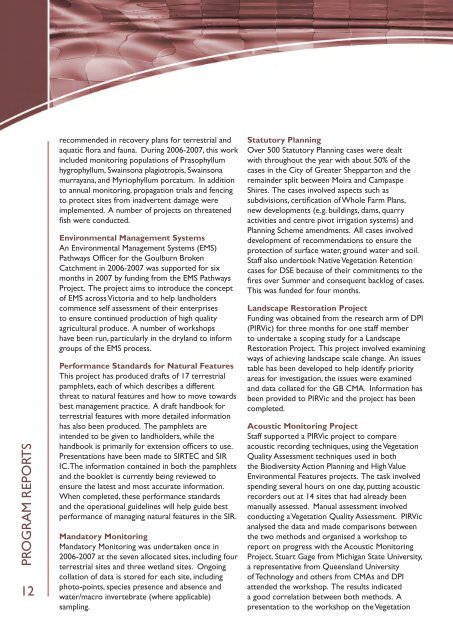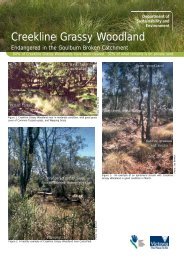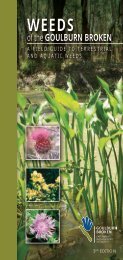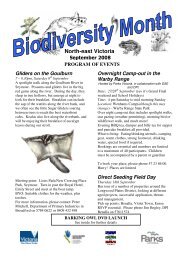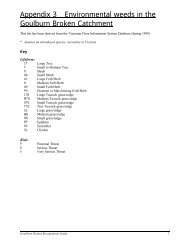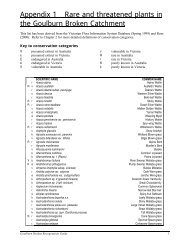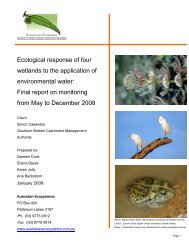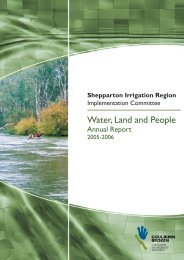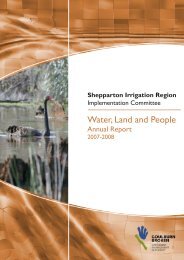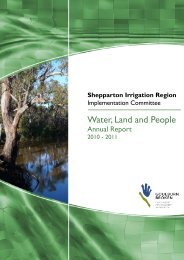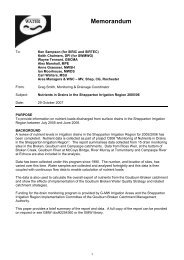Water, Land and People - Goulburn Broken Catchment ...
Water, Land and People - Goulburn Broken Catchment ...
Water, Land and People - Goulburn Broken Catchment ...
Create successful ePaper yourself
Turn your PDF publications into a flip-book with our unique Google optimized e-Paper software.
PROGRAM REPORTS<br />
12<br />
recommended in recovery plans for terrestrial <strong>and</strong><br />
aquatic flora <strong>and</strong> fauna. During 2006-2007, this work<br />
included monitoring populations of Prasophyllum<br />
hygrophyllum, Swainsona plagiotropis, Swainsona<br />
murrayana, <strong>and</strong> Myriophyllum porcatum. In addition<br />
to annual monitoring, propagation trials <strong>and</strong> fencing<br />
to protect sites from inadvertent damage were<br />
implemented. A number of projects on threatened<br />
fish were conducted.<br />
Environmental Management Systems<br />
An Environmental Management Systems (EMS)<br />
Pathways Officer for the <strong>Goulburn</strong> <strong>Broken</strong><br />
<strong>Catchment</strong> in 2006-2007 was supported for six<br />
months in 2007 by funding from the EMS Pathways<br />
Project. The project aims to introduce the concept<br />
of EMS across Victoria <strong>and</strong> to help l<strong>and</strong>holders<br />
commence self assessment of their enterprises<br />
to ensure continued production of high quality<br />
agricultural produce. A number of workshops<br />
have been run, particularly in the dryl<strong>and</strong> to inform<br />
groups of the EMS process.<br />
Performance St<strong>and</strong>ards for Natural Features<br />
This project has produced drafts of 17 terrestrial<br />
pamphlets, each of which describes a different<br />
threat to natural features <strong>and</strong> how to move towards<br />
best management practice. A draft h<strong>and</strong>book for<br />
terrestrial features with more detailed information<br />
has also been produced. The pamphlets are<br />
intended to be given to l<strong>and</strong>holders, while the<br />
h<strong>and</strong>book is primarily for extension officers to use.<br />
Presentations have been made to SIRTEC <strong>and</strong> SIR<br />
IC. The information contained in both the pamphlets<br />
<strong>and</strong> the booklet is currently being reviewed to<br />
ensure the latest <strong>and</strong> most accurate information.<br />
When completed, these performance st<strong>and</strong>ards<br />
<strong>and</strong> the operational guidelines will help guide best<br />
performance of managing natural features in the SIR.<br />
M<strong>and</strong>atory Monitoring<br />
M<strong>and</strong>atory Monitoring was undertaken once in<br />
2006-2007 at the seven allocated sites, including four<br />
terrestrial sites <strong>and</strong> three wetl<strong>and</strong> sites. Ongoing<br />
collation of data is stored for each site, including<br />
photo-points, species presence <strong>and</strong> absence <strong>and</strong><br />
water/macro invertebrate (where applicable)<br />
sampling.<br />
Statutory Planning<br />
Over 500 Statutory Planning cases were dealt<br />
with throughout the year with about 50% of the<br />
cases in the City of Greater Shepparton <strong>and</strong> the<br />
remainder split between Moira <strong>and</strong> Campaspe<br />
Shires. The cases involved aspects such as<br />
subdivisions, certification of Whole Farm Plans,<br />
new developments (e.g. buildings, dams, quarry<br />
activities <strong>and</strong> centre pivot irrigation systems) <strong>and</strong><br />
Planning Scheme amendments. All cases involved<br />
development of recommendations to ensure the<br />
protection of surface water, ground water <strong>and</strong> soil.<br />
Staff also undertook Native Vegetation Retention<br />
cases for DSE because of their commitments to the<br />
fires over Summer <strong>and</strong> consequent backlog of cases.<br />
This was funded for four months.<br />
<strong>L<strong>and</strong></strong>scape Restoration Project<br />
Funding was obtained from the research arm of DPI<br />
(PIRVic) for three months for one staff member<br />
to undertake a scoping study for a <strong>L<strong>and</strong></strong>scape<br />
Restoration Project. This project involved examining<br />
ways of achieving l<strong>and</strong>scape scale change. An issues<br />
table has been developed to help identify priority<br />
areas for investigation, the issues were examined<br />
<strong>and</strong> data collated for the GB CMA. Information has<br />
been provided to PIRVic <strong>and</strong> the project has been<br />
completed.<br />
Acoustic Monitoring Project<br />
Staff supported a PIRVic project to compare<br />
acoustic recording techniques, using the Vegetation<br />
Quality Assessment techniques used in both<br />
the Biodiversity Action Planning <strong>and</strong> High Value<br />
Environmental Features projects. The task involved<br />
spending several hours on one day, putting acoustic<br />
recorders out at 14 sites that had already been<br />
manually assessed. Manual assessment involved<br />
conducting a Vegetation Quality Assessment. PIRVic<br />
analysed the data <strong>and</strong> made comparisons between<br />
the two methods <strong>and</strong> organised a workshop to<br />
report on progress with the Acoustic Monitoring<br />
Project. Stuart Gage from Michigan State University,<br />
a representative from Queensl<strong>and</strong> University<br />
of Technology <strong>and</strong> others from CMAs <strong>and</strong> DPI<br />
attended the workshop. The results indicated<br />
a good correlation between both methods. A<br />
presentation to the workshop on the Vegetation


